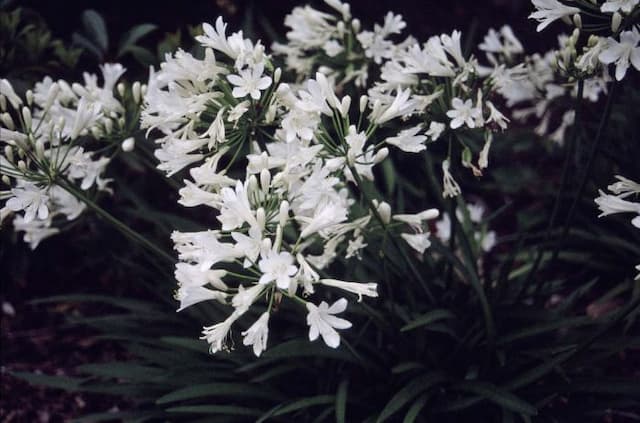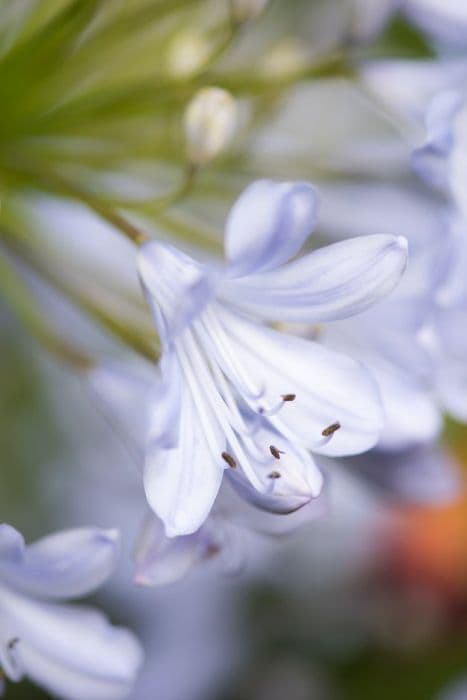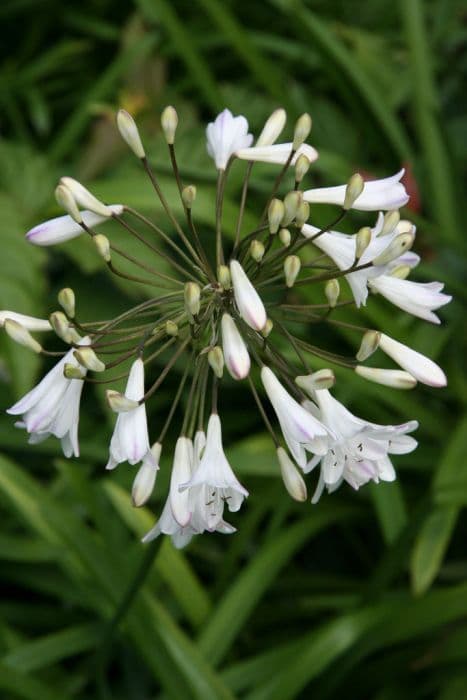Lily of the Nile Agapanthus 'Sandy' (PBR)

ABOUT
Agapanthus 'Sandy' is a striking ornamental plant known for its elegant appearance. It typically features luscious, strappy green foliage that forms a neat, evergreen clump, giving it a lush and inviting look throughout the year. Emerging from this verdant base are sturdy stems that reach upward, each stem culminating in a grand display of delicate, trumpet-shaped flowers. The blooms of Agapanthus 'Sandy' are renowned for their unique coloration. Each flower petal exhibits a soft blend of cream and pale blue, with hints of lilac, creating a beautifully muted pastel effect. These blossoms are arranged in a large, rounded cluster, often called an umbel, which sits like a regal crown atop its stem. The individual flowers are symmetrically shaped, and their gentle convergence at the tips forms a subtle point, giving each inflorescence a slightly star-like quality when viewed from a distance. The overall appearance of Agapanthus 'Sandy' exudes a sense of grace and sophistication, making it a popular choice for ornamental gardens and borders. Its flowers are particularly beloved for their ability to attract butterflies and other pollinators, adding not only visual beauty but also ecological value to the spaces where they are planted. With its lovely foliage and captivating floral displays, Agapanthus 'Sandy' is truly a gem of the garden, offering a sense of tranquility and natural elegance.
About this plant
 Names
NamesFamily
Amaryllidaceae
Synonyms
African Lily, Lily of the Nile
Common names
Agapanthus 'Sandy' (PBR)
 Toxicity
ToxicityTo humans
Agapanthus, commonly known as Lily of the Nile, is not considered highly toxic to humans. However, all parts of the plant contain sap that can cause skin irritation and upset stomach if ingested. Symptoms of mild poisoning can include nausea, vomiting, and diarrhea. It is important to handle the plant with care and avoid ingestion.
To pets
Lily of the Nile is toxic to pets such as dogs and cats. If a pet ingests any part of the plant, it can cause gastrointestinal upset, vomiting, and diarrhea. In severe cases, symptoms could escalate to tremors or heart issues. It is advisable to keep this plant out of reach of pets to prevent any accidental ingestion.
 Characteristics
CharacteristicsLife cycle
Perennials
Foliage type
Evergreen
Color of leaves
Green
Flower color
Blue
Height
2 feet (60 cm)
Spread
2 feet (60 cm)
Plant type
Bulb
Hardiness zones
8
Native area
South Africa
Benefits
 General Benefits
General Benefits- Attractive Flowers: The Agapanthus 'Sandy' (also known as the African Lily) produces beautiful blue or violet flowers that add color and visual interest to any garden.
- Drought Tolerant: Once established, the African Lily is relatively drought tolerant, making it suitable for gardens in drier climates or for gardeners seeking low-water plants.
- Long Blooming Season: With a long flowering period from mid-summer to early fall, the plant offers extended beauty in the landscape.
- Low Maintenance: This plant requires minimal care once established, making it ideal for both novice gardeners and those with limited time for gardening.
- Attracts Pollinators: The blooms of Agapanthus 'Sandy' attract bees, butterflies, and other beneficial pollinators to the garden, supporting local ecosystems.
- Suitable for Containers: It is well-suited for container gardening, allowing versatility in placement and the ability to grow it even in small spaces or on patios.
- Architectural Appeal: The plant’s strappy leaves and tall flower stalks provide an architectural element which can be used to create focal points in garden designs.
- Perennial Growth: As a perennial, the African Lily will return year after year, reducing the need for replanting and providing lasting value.
- Resistant to Pests: It exhibits resistance to many pests, reducing the need for chemical treatments and creating a more sustainable garden environment.
- Deer Resistant: The plant is known to be unattractive to deer, which can benefit gardeners in areas where deer browse on garden plants.
 Medical Properties
Medical PropertiesThis plant is not used for medical purposes.
 Air-purifying Qualities
Air-purifying QualitiesThis plant is not specifically known for air purifying qualities.
 Other Uses
Other Uses- Agapanthus 'Sandy' can be used in dye production, with its blooms contributing to natural dye shades ranging from blues to purples, depending on the mordant used.
- In floral photography, the striking blue to violet hues of Agapanthus 'Sandy' provide striking subjects for macro photography, elevating the aesthetic appeal of photo collections.
- In eco-printing, a process where plants are used to leave direct impressions on fabric, Agapanthus 'Sandy' can leave interesting shapes and colors when used on textiles.
- The tall and sturdy flower stalks can be utilized in the art of flower pressing, their unique shapes creating impressive silhouettes on pressed flower artworks.
- As a source of food for hummingbirds and butterflies, Agapanthus 'Sandy’'s nectar-rich flowers can attract these pollinators to gardens for observation and photography.
- The flower's seed heads can be incorporated into dry flower arrangements or used as a natural addition to wreaths and other rustic craft projects.
- Agapanthus 'Sandy' can serve as a natural pest deterrent when strategically planted; its sap has been known to repel certain types of deer and rodents that avoid its taste.
- In landscape design, Agapanthus 'Sandy' can be used to create impressions of water with its blue-toned flowers, especially in rock gardens that mimic the flow of a stream.
- The robust roots of Agapanthus 'Sandy' may be utilized in soil stabilization projects on slopes or in areas prone to erosion, to help hold the soil together.
- As a subject for botanical illustration, the plant offers complex structures and vibrant colors that serve as an excellent study for artists focusing on botanical accuracy.
Interesting Facts
 Feng Shui
Feng ShuiThe Agapanthus, commonly known as Lily of the Nile, is not specifically used in Feng Shui practice.
 Zodiac Sign Compitability
Zodiac Sign CompitabilityThe Agapanthus, commonly known as Lily of the Nile, is not used in astrology practice.
 Plant Symbolism
Plant Symbolism- Love Letters: The Agapanthus, commonly known as the African Lily, is often seen as a symbol of love and can be likened to a love letter due to its delicate and bountiful blooms that have a poetic flow and grace.
- Enduring Love: With its sturdy stems and lush, rounded flower heads, the African Lily can symbolize the endurance and constancy of love, signaling a relationship that is resilient and long-lasting.
- Fertility: The prolific nature of its flowering can symbolize fertility and abundance, making it a common gift for those wishing to start or celebrate the growth of their families.
- Beauty: The striking appearance of the African Lily's blue, violet, or white flowers makes it a symbol of beauty and elegance, often used in gardens and bouquets to create an atmosphere of sophistication.
- Freedom: Some view the African Lily as symbolizing freedom due to the way the flowers freely bloom and open to the sky, representing an unrestrained spirit and openness to the world.
 Water
WaterAfrican Lily, commonly known as Agapanthus 'Sandy', requires consistent moisture during the growing season. Water it deeply once a week, providing about one to one and a half gallons per plant to encourage deep root growth. During hot spells or in especially dry climates, you might need to water twice a week. In the winter, reduce watering significantly to prevent root rot, since the plant is dormant and requires less moisture. Overwatering can be as damaging as under-watering, so ensure the soil is well-draining.
 Light
LightThe African Lily thrives in full sun to partial shade. It prefers a spot that receives at least six hours of direct sunlight daily. If you live in an area with intense summer heat, afternoon shade can help protect the plant from scorching.
 Temperature
TemperatureThe African Lily can survive in temperatures as low as 20 degrees Fahrenheit but prefers a range between 50 to 80 degrees Fahrenheit for optimal growth. It's a hardy plant that can tolerate brief periods of cold, but prolonged exposure to temperatures below freezing may damage the plant.
 Pruning
PruningPruning the African Lily is primarily to remove spent flower stalks and tidy up the plant's appearance. Deadhead the flowers after they fade to encourage more blooms. Cut back the foliage only after it has died back naturally, usually in late fall or early winter, to clean up the plant and prepare it for the next growing season.
 Cleaning
CleaningAs needed
 Soil
SoilLily of the Nile prefers well-draining soil with a pH between 6.0 to 8.0. The best soil mix is a combination of loamy garden soil, compost, and a small amount of sand or perlite to improve drainage. Regular feeding with a balanced fertilizer during the growing season supports healthy growth.
 Repotting
RepottingLily of the Nile should be repotted every 2 to 3 years or when it becomes root-bound. They can often benefit from division at the time of repotting to help rejuvenate the plant and encourage more vigorous flowering.
 Humidity & Misting
Humidity & MistingLily of the Nile does well in average ambient humidity. It does not have specific humidity requirements but should not be placed in extremely dry environments. Keeping it in a naturally humid outdoor setting or a typical room humidity indoors is generally sufficient.
 Suitable locations
Suitable locationsIndoor
Place Lily of the Nile in bright indirect light.
Outdoor
Plant Lily of the Nile in full sun to part shade.
Hardiness zone
8-11 USDA
 Life cycle
Life cycleThe life of the Agapanthus 'Sandy', commonly known as the African Lily, begins with seed germination, where the seeds require a warm temperature and sufficient moisture to sprout. The seedlings then develop into young plants, growing elongated, strappy leaves. As it matures, the plant forms a rhizome or fleshy root system from which new foliage emerges each season. The African Lily reaches its flowering stage in the summer, displaying clusters of trumpet-shaped flowers on tall, sturdy stalks. After pollination, if it occurs, the flowers produce seed pods which eventually dry and release seeds to complete the reproductive cycle. With adequate care, the African Lily enters a period of dormancy in the winter, during which it conserves energy before resuming growth in the spring.
 Propogation
PropogationPropogation time
Early Summer
The most popular method for propagating the Agapanthus 'Sandy', commonly known as the African Lily, is through division. The ideal time for this procedure is in late spring or early summer after the plant has finished blooming. To propagate by division, carefully lift the parent plant from the ground using a spade, ensuring that you do not damage the root ball. Gently separate the clumps into smaller sections, each with a few shoots and a portion of the root system. Replant the divisions at the same soil depth as the original plant and space them about 18 inches (approximately 45.72 centimeters) apart to ensure they have ample room to grow. Water the newly planted divisions thoroughly to help establish them. This method allows gardeners to quickly increase their stock of African Lilies while ensuring the plants are true to the parent variety.



![African lily [Blue Storm]](/_next/image?url=https%3A%2F%2Fplants-admin.emdemapps.com%2Fimages%2Fplants%2F%2Fimages%2F604b63200a08b.png&w=640&q=75)





